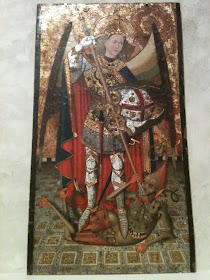Christ Child with an Apple. Willow with original pain and traces of gilding. Michel Erhart, Germany, c.1475.
Thanks to a collection of free passes acquired by my daughter Zombelina, I was encouraged all the more to make the return trip to the northernmost tip of the island of Manhattan a couple of months ago to once again immerse ourselves in the twisted imaginings of the pre-Renaissance Western world, when the oppressive yoke of religion forced its will upon everything, and turned men's minds to thoughts of a most bizarre nature.
That's not to say that there isn't a lot of pleasantness here, as well; although I chose to pictorialize only the most frightening imagery for the purposes of this rather single-minded blog, I would encourage a visit to The Cloisters for many other reasons, including the peaceful herb garden (don't eat the hemlock) and the magnificent views of the might Hudson River.
Sadly, we were ousted abruptly due to an earlier-than-expected closing time, and so I'm proud to say we returned once again a mere few weeks later. Two visits to The Cloisters in one summer! It gets no better. Well, enough of the wistful musing! On to the gloom and doom...
Saint Michael. Tempera, oil, gold and silver on wood. Master of Belmonte, Spain, c.1475. The detail on Lucifer is quite gruesome, indeed.
From Panels with the Crucifixion and the Lamentation. Tempera on wood with tooled gold ground. Master of the Codex of St. George, Italy, 14th century.
House Altarpiece. Oil and gold on wood; metal fixtures. Germany, c.1490. That's St. Anne, holding both her inexplicably diminutive daughter Mary and her grandson Jesus.
The Lamentation (detail). Walnut with paint and gilding. Spain, c.1480. Originally found in a Benedictine monastery, the intense emotion was meant to urge the faithful to imagine themselves present at the death of Christ.
Altarpiece with Scenes from the Life of Saint Andrew (detail). Tempera on gold and wood. The Master of Roussillon, Catalan, c.1425.
Altar Frontal with the Man of Sorrows (detail). Wool, linen and metal thread. Germany, c.1465. "Man of Sorrows" was a common medieval euphemism for J.C. himself. Note the amount of blood, consistent with passion plays of the Middle Ages.
Wooden sculpture of a lamenting woman, presumably Mary. Sadly, I did not get the details on this one.
Lurking in the herb garden...










The Cloisters - you are correct. A hidden jem. Very nice post and yes, first photo very creepy. ha.
ReplyDeleteI actually texted that photo to my girlfriend, just to freak her out...
ReplyDeleteI liked the first picture Would you mind that you posted on my Twitter
ReplyDeleteIf you're asking if you can post it on your Twitter--please, go right ahead!
ReplyDeleteMerry Christmas B-Sol, have a great time geezer.
ReplyDeleteHappy New Year B-Sol, have a great 2014 my old mate.
ReplyDeleteThe painting looks really cool but I dont like the statue. It looks really strange to me.. I'm a christian by faith but I don't believe in statue in the church or somewhere...
ReplyDeleteAnything new coming?
ReplyDeleteMy schedule has been super busy for the past year, Gatekeeper. We shall see.
ReplyDelete